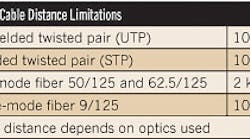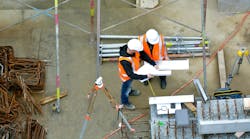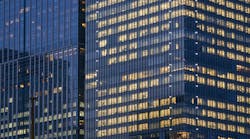Requirements for cabling and other interconnectivity infrastructure products vary widely when you compare traditional commercial environments like office buildings to industrial environments, which include factory floors, processing facilities, and wastewater treatment plants to name a few. For starters, standard commercial environments are generally free from fine particulates, liquids, and temperature extremes. Although industrial environments contain some or all of these conditions, they also hold the potential for shock, vibration, and interference from electromagnetic interference (EMI) and radio frequency interference (RFI).
When designing your network, before selecting the type of cabling to specify, it's important to understand exactly what type of industrial environment you're dealing with, given the differences between traditional commercial controlled environments and harsh industrial environments.
Controlled environments
Traditional controlled environments can include small office/home office (SOHO), small to medium business (SMB), and large enterprise networks where interconnect components are not exposed to dust, moisture, chemicals, RFI, or EMI. For these installations, many products are available from a host of manufacturers.
Much of the infrastructure cabling is placed in the plenum airspace above ceiling tiles or is run inside of walls where it goes untouched for years. Each intermediate distribution frame (IDF) and the main distribution frame (MDF) are typically climate-controlled with HVAC systems that keep the premise cabling — as well as the active equipment, such as switches, routers, and servers — at a constant temperature and humidity level. For these types of installations, a combination of copper unshielded twisted pair (UTP) and fiber-optic cabling generally is used. Fiber-optic cabling is used for longer runs between floors of a building and sometimes underground in a conduit or direct burial to connect multiple campus buildings (click here to see Fig. 1)
Uncontrolled environments
Industrial environments often include manufacturing facilities, onshore and offshore petroleum processing operations, coal mines, wastewater treatment facilities, and transportation systems, including tunnels, subways, etc. These harsh uncontrolled environments include indoor as well as outdoor installations where temperature extremes, moisture, shock, vibration, and exposure to chemicals are prevalent. When designing a cabling infrastructure for these types of conditions, special consideration is required.
EMI/RFI
Motors and generators often are located right next to or in close proximity to network cabling. EMI and RFI can interfere with data transmission on a copper cable and cause downtime and errors. To lessen or eliminate their effects, you must use interference-shielded cables and connectors.
Typically, two types of cable shields are used: braided and foil. Although foil shielding provides 100% coverage of the conductors, it's difficult to effectively terminate to connectors with this method. It also offers high resistance, which doesn't provide the best path to ground.
Braided shield generally offers 60% to 85% shielding and can only offer about 95% coverage at best. The mass of the braid is heavier than a foil shield; therefore, it provides better conductivity and offers a good secure connection to the connectors at the cable ends, providing an excellent ground. Some shielded cables offer both foil and braided shields. These types of cables offer a higher level of protection from EMI/RFI (click here to see Fig. 2) than the previous two just mentioned.
When building a shielded cable plant, it's important to use shielded cable, shielded connectors, and shielded interconnection points (such as patch panels) for the shielding to be effective against EMI /RFI. Additionally, proper bonded grounding of all components is crucial to attaining effective shielding.
Jacket types
Another consideration when designing a cabling plant in harsh environments is the cable jacket. In some cases, robotic equipment is directly connected via Cat. 5/5e or 6 cables, which are constantly moving and require a cable constructed with a hi-flex, low-friction jacket as well as robust connectors to ensure a high mean time between failures (MTBF). Other environments call for cabling that can be exposed to petroleum-based products or other chemicals. Traditional PVC jacketed cables would break down when exposed to these harsh liquids.
If protection of personnel or equipment is a design requirement, then you should consider using low smoke zero halogen (LSZH) jacketed cables. LSZH cables give off fewer toxic fumes than their standard PVC-based cable jacket counterparts. Typically, LSZH cabling is used in confined spaces, such as mining operations.
Fiber optics
The use of fiber-optic cabling in industrial installations has grown over the years as an alternative to traditional shielded cabling, as fiber cabling is impervious to EMI and RFI. Additionally, fiber-optic cables can extend great distances when compared to copper cables without the use of costly and cumbersome repeaters. Although fiber is more difficult to terminate in the field and costs more than STP cabling, the price for fiber has continued to decline over time. With more offshore, lower cost fiber manufacturing, this trend should continue.
In some cases, fiber may only be needed in certain areas of an industrial cable plant — near high EMI areas or between facilities where copper falls short due to distance limitations (see Table 1). If this is the case, relatively low-cost media converters can preserve the existing copper infrastructure investment and allow access to fiber runs where required.
Harsh environment rating systems
The National Electrical Manufacturers Association (NEMA) and the International Electrotechnical Commission (IEC) have devised rating systems for products (such as cable assemblies, enclosures, etc.) that define the products' resistance to dust, moisture, water immersion, and ice. The IEC's rating is referred to as the ingress protection (IP) rating. Table 2 (click here to see Table 2)outlines various NEMA and IEC IP enclosure ratings.
As far as cable assemblies and IP ratings go, proper termination is essential to qualify for an IP rating. The connectors and cable must be properly terminated per the manufacturer's specifications in order to effectively meet an IP rating. If the assembly is not built correctly, liquids, debris, and fine particulates can eventually cripple a network.
When designing a network, you must consider the operating environment not only for active equipment, such as Ethernet switches, but also for cabling, connectors, patch panels, wall plates, and enclosures to ensure optimal network performance.
McNeil is a manager with L-com Global Connectivity, headquartered in North Andover, Mass. He can be reached at [email protected].




